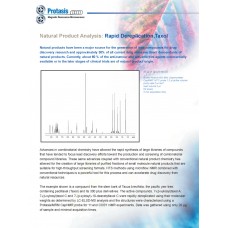Shopping Cart
0 item(s) - $0.00Taxol Application Note
Add to Compare
Ask a question
Your Name:Your Email:
Your Question: Note: HTML is not translated!
Enter the code in the box below:
Natural products have been a major source for the generation of lead compounds for drug
discovery research and approximately 30% of all current drug sales are direct descendants of
natural products. Currently, about 60 % of the anti-tumour and anti-infective agents commercially
available or in the later stages of clinical trials are of natural product origin.
Advances in combinatorial chemistry have allowed the rapid synthesis of large libraries of compounds
that have tended to focus lead discovery efforts toward the production and screening of combinatorial
compound libraries. These same advances coupled with conventional natural product chemistry has
allowed for the creation of large libraries of purified fractions of small molecule natural products that are
suitable for high-throughput screening formats. HTS methods using microflow NMR combined with
conventional techniques is a powerful tool for this process and can accelerate drug discovery from
natural resources.
The example shown is a compound from the stem bark of Taxus brevifolia, the pacific yew tree,
containing paclitaxel (Taxol) and its 300 plus derivatives. The active compounds, 7-(β-xylosyl)taxol A,
7-(β-xylosyl)taxol C and 7-(β-xylosyl)-10-deacetyltaxol C were rapidly dereplicated using their molecular
weights as determined by LC-ELSD-MS analysis and the structures were characterised using a
Protasis/MRM CapNMR probe for 1H and COSY NMR experiments. Data was gathered using only 20 µg
of sample and minimal acquisition times.
Write a review
Your Name:Your Review: Note: HTML is not translated!
Rating: Bad Good
Enter the code in the box below:
The microNMR Outlet © 2026









